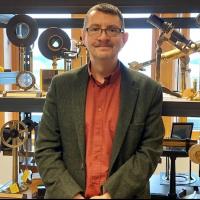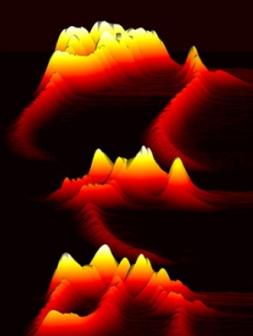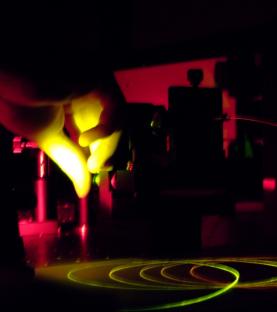Welcome to my website which provides an overview of my research activities (below) and outreach activities (here). For more up to date news, you can follow me on Twitter-X at @johnmdudley. You can also follow posts on the International Day of light at @IDLOfficial
If you wish to follow my latest publications, then please check out one of the links below. Please contact me if you need a copy of any paper or conference proceedings.
Publications and Profile on Google Scholar
Publications and Profile on Web of Science
Publications and Profile on ORCID
Details of my outreach activities are on this page
Research
Genetic Algorithms for Laser and Supercontinuum control
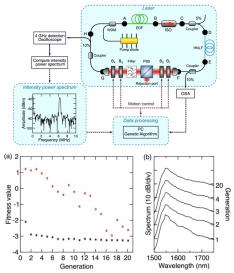
Two recent papers of ours have reported exciting results where we use machine learning to control different classes of fibre-based source. In the first, a genetic algorithm was used to optimise the intracavity saturable absorber characteristics of a broadband noise-like pulse (NLP) laser. NLP lasers are a highly complex class of ultrafast source where the output temporal and spectral characteristics depend on the precise optimisation of the fibre parameters, especially the positions of intracavity polarisation elements that constitute the saturable absorber. In our work we showed that a genetic algorithm can rapidly locate the optimal settings of 4 intracavity polarisation control elements to modify the satirable absorber transfer function in order to generate the broadest bandwidths spanning 100's of nm. In the second paper, a genetic algorithm is used to shape the properties of input pulses that generate broadband supercontinuum. The idea is to target enhanced spectral bandwidth in particular wavelength ranges, and a genetic algorithm is shown to be an effective means of achieving this at one, or even over multiple wavelengths over 1550-2000 nm ,
Selected Publications
C. Lapre, F. Meng, M. Hary, C. Finot, G. Genty, J. M. Dudley. Genetic algorithm optimization of broadband operation in a noise-like pulse fiber laser. Scientific Reports 13, 1865 (2023).
M. Hary, L. Salmela, P. Ryczkowski, F. Gallazzi, J. M. Dudley, and G. Genty, Tailored supercontinuum generation using genetic algorithm optimized Fourier domain pulse shaping. Optics Letters 48, 4512-4515 (2023).
F. Meng, C. Lapre, C. Billet, T. Sylvestre, J.-M. Merolla, C. Finot, S. K. Turitsyn, G. Genty, J. M. Dudley. Intracavity incoherent supercontinuum dynamics and rogue waves in a broadband dissipative soliton laser. Nature Communications 12, 5567 (2021)
Data-driven Machine Learning for New Insights into Nonlinear Fibre Optics
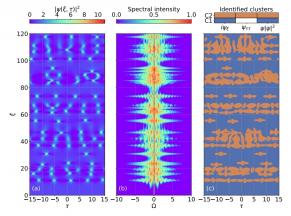
In the field of nonlinear fibre optics, we have been carrying out systematic studies over the last few years into the use of algorithms to analyse data to drive the construction of new physical models or to otherwise gain insight into the physics of nonlinear fibre propagation. Our recent work has focussed on two areas: (i) inverting nonlinear time-series data to discover physical differential equation models for optical fibre four wave mixing dynamics; (ii) applying cluster analysis and principal component analysis to automatically identify dominant physical interactions present in nonlinear instability and rogue wave formation in optical fibre. Our results are revealing exciting opportunities to apply new numerical methods to further of physical understanding of nonlinear systems in nature. We are initially applying the techniques in the field of nonlinear fibre optics (an area we know well!) but the techniques are general and can be applied much more widely to other physical systems.
Selected Publications
A. V. Ermolaev, A. Sheveleva, G. Genty, C. Finot, J. M. Dudley, Data-driven model discovery of ideal four-wave mixing in nonlinear fibre optics, Scientific Reports 12, 12711 (2022).
A. V. Ermolaev, M. Mabed, C. Finot, G. Genty, J. M. Dudley, Analysis of interaction dynamics and rogue wave localization in modulation instability using data-driven dominant balance, Scientific Reports 13, 10462 (2023).
Fifty Years of Solitons in Optical Fibre
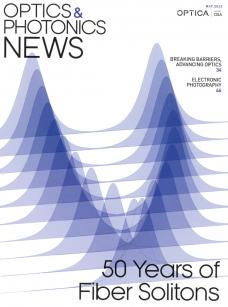
In August 1834, the Scottish engineer John Scott Russell saw an extraordinary sight on the Union Canal near Edinburgh. While studying how hull design influenced the speed of canal boats, he observed what he called a “great solitary wave” that traveled for miles without spreading. We now understand that such stable wave propagation requires a precise balance between linear and nonlinear effects—and the study of such solitary waves, or solitons, has become central to the field of nonlinear science. Solitons in optics were first observed in the early 1960s, in spatial trapping and filamentation seen when the newly invented laser was focused into dielectrics and other media.
Then, in 1973—almost exactly 50 years ago—Akira Hasegawa and Fred Tappert showed that the 1D NLSE described pulse propagation in optical fiber. They predicted the existence of stable temporal solitons that could be used for optical communications. In this paper published in Optica's flagship magazine Optics & Photonics News, we celebrate the 50th anniversary of Hasegawa and Tappert’s pioneering work with a semi-popular account of their properties and impact, including some mention of our own work in this field. Our article even got on the cover!
Selected Publications
J. M. Dudley, C. Finot, G. Genty, R. Taylor. Fifty Years of Fiber Solitons. Optics and Photonics News 34(5) 26-33 (2023)
B. Kibler, J. M. Dudley, C. Finot. Pioneering Experiments on Optical Solitons in FibresPhotoniques 122 41-45 (2023)
Artificial Intelligence in Ultrafast Photonics
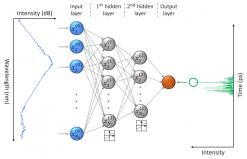
For several years, I have been working on using machine learning techniques in the particular field of ultrafast nonlinear photonics, both for practical improvement of broadband laser sources, as well as for more fundamentally-oriented studies of physical systems, aiming to use algorthimic analysis of data to determine new physical models and to identify dominant physical interactions. This work has involved the use of a range of standard machine learning tools such as feedforward and recurrent neural networks, sparse regression, and multidimensional cluster search. Experimentally, we have developed genetic algorithm approaches to optimising mode-locked lasers and supercontinuum sources,
Selected Publications
G. Genty, L. Salmela, J. M. Dudley et al. Machine learning and applications in ultrafast photonics, Nature Photonics 183, 91-101 (2021)
A. V. Ermolaev, A. Sheveleva, G. Genty, C. Finot, J. M. Dudley, Data-driven model discovery of ideal four-wave mixing in nonlinear fibre optics, Scientific Reports 12, 12711 (2022).
C. Lapre, F. Meng, M. Hary, C. Finot, G. Genty & J. M. Dudley. Genetic algorithm optimization of broadband operation in a noise-like pulse fiber laser. Scientific Reports 13, 1865 (2023)
Source Development, Instabilities, Characterization and Control
I have been studying ultrafast lasers since my PhD, and the rich dynamics of laser physics continues to fascinate me. The recent development of advanced pulse measurement techniques such as the dispersive Fourier transform and the time lens afford characterization possibilities that were only dreamt of 2 decades ago. The ability to perform real-time spectral and temporal characterization has opened up new possibilities to directly study the fundamental origins of ultrafast laser buildup and instability. My work in this area initially focussed on studies of supercontinuum noise and spectral correlations, but has recently expanded to explore open questions in mode-locked laser dynamics. In fact, although the dynamics of mode-locked lasers have been studied since the very early days of laser physics, there are important and fundamental open questions regarding the operation and physics of dissipative soliton laser, when the laser operation is governed by not only gain and loss, but also dispersion and nonlinearity, and sometimes highly dissipative spectral filtering. At the same time, the availability of convenient machine learning tools opens entirely new and potentially revolutionary approaches for analysis and control of pulsed laser operation and nonlinear propagation. This area of research is not only of fundamental interest, but also promises to set the scene for the next generation of fibre laser source.
Selected Publications
P. Ryczkowski, M. Närhi, C. Billet, J.-M. Merolla, G. Genty, J. M. Dudley, Real-time full-field characterization of transient dissipative soliton dynamics in a mode-locked laser, arXiv:1706.08571, Nature Photonics 12, 221-227 (2018).
M. Närhi, L. Salmela, J. Toivonen, C. Billet, J. M. Dudley, G. Genty, Machine learning analysis of extreme events in optical fibre modulation instability, Nature Communications 9 4923 (2018)
C. Lapre, C. Billet, F. Meng, P. Ryczkowski, T. Sylvestre, C. Finot, G. Genty, J. M. Dudley, Real-time characterization of spectral instabilities in a mode-locked fibre laser exhibiting soliton-similariton dynamics, Scientific Reports 9, 13950 (2019)
L. Salmela, C. Lapre, J. M. Dudley, G. Genty, Machine learning analysis of rogue solitons in supercontinuum generation, Scientific Reports 10, 9596 (2020)
F. Meng, J. M. Dudley, Toward a self-driving ultrafast fiber laser, Light: Science and Applications 9 26 (2020)
M. Mabed, F. Meng, L. Salmela, C. Finot, G. Genty, J. M. Dudley. Machine learning analysis of instabilities in noise-like pulse lasers. Optics Express 30, 15060-15072 (2022)
M. Mabed, L. Salmela, A. Ermolaev, C. Finot, G. Genty, J. M. Dudley. Neural network analysis of unstable temporal intensity peaks in continuous wave modulation instability. Optics Communications 541, 129570 (2023)
Supercontinuum Physics
A key area of my research since 2000 has focused on studying nonlinear propagation and supercontinuum generation in highly nonlinear and photonic crystal fibers (PCF). This work has involved experiments carried out by my own group in France, as well as analysis of results from a number of international groups. Major results have included: first demonstration of PCF supercontinuum generation in the nanosecond regime using a compact microchip laser system; detailed numerical modeling of pulse propagation and supercontinuum generation in PCF in both the nanosecond and femtosecond regimes; definition of a quantitative measure of spectral coherence; use of the spectrogram representation to physically interpret the complex dynamics. In 2006, I co-wrote the first major review of the field of PCF supercontinuum generation, but it should be remarked that this paper is far more than just a compilation of published results; we carried out many original numerical studies to illustrate previously unknown features of the dynamics, and to aid in experimental design. In 2010, I co-edited a book with a selection of papers by experts that updated the supercontinuum state of the art. I am currently working on extending the supercontinuum to new wavelength ranges and continuing studies of techniques for noise reduction, particularly in the mid-IR. This work has been funded by the Horizon 2020 ITN Project SUPUVIR.
Selected Publications
J. M. Dudley, G. Genty, S. Coen, Supercontinuum Generation in Photonic Crystal Fiber,
Reviews of Modern Physics 78 1135-1184 (2006)
J. M. Dudley and J. R. Taylor, Ten years of nonlinear optics in photonic crystal fibre: progress and perspectives,
Nature Photonics 3 85-90 (2009)
J. M. Dudley and J. R. Taylor (Eds) Supercontinuum Generation in Optical Fiber, Cambridge University Press, 400 pages, ISBN 978-0521514804 (2010)
E. Genier, P. Bowen, T. Sylvestre, J. M. Dudley, P. Moselund, O. Bang, Amplitude noise and coherence degradation of femtosecond supercontinuum generation in all-normal-dispersion fibers, Journal of the Optical Society of America B, 36 A161-167 (2019)
T. Sylvestre, E. Genier, A. N. Ghosh, P. Bowen, G. Genty, J. Troles, A. Mussot, A. C. Peacock, M. Klimczak, A. M. Heidt, J. C. Travers, O. Bang, J. M. Dudley, Recent advances in supercontinuum generation in specialty optical fibers, Journal of the Optical Society of America B, 38 F90-F103 (2021)
Rogue Waves
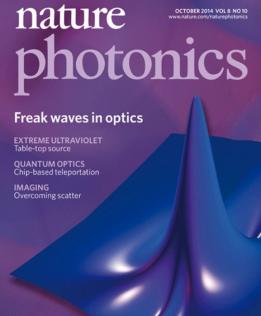
The importance of the supercontinuum as a technological light source motivated intense interest into its noise and stability properties which subsequently opened up a new field of research into optical rogue waves. The idea here is that the instabilities observed on a light wave propagating in an optical medium are analogous to those that drive the emergence of giant waves on the surface of the ocean. My work here has been carried out in the frame of an ANR grant MANUREVA and an ERC Advanced Co-Investigator Grant MULTIWAVE (with F Dias from UCD Dublin) where the aim was to study potential analogies between ocean waves and light waves carefully and in detail. We took our time with MULTIWAVE to do things properly, as when we began our work there were all sorts of papers being rushed into print proposing analogies between ocean waves and optics in systems where no such analogy existed. We like to think that the work in MULTIWAVE has led to some structure being introduced into this field. MULTIWAVE completed in 2016, but our work led to a number of significant results in the field of optical rogue waves, some of which were summarised in a 2014 paper paper in Nature Photonics. I am currently working on developing new measurement techniques to provide new insights into the complex optical rogue wave dynamics, as well as to explore some new approaches to developing an even better understanding of the underlying physics. Some key publications are listed below, including a significant 2019 review paper in Nature Reviews Physics that highlights the state of the art of rogue wave research in both oceanography and optics. I am currently using machine learning methods
to gain further insights into the physics of rogue wave emergence.
Selected Publications
B. Kibler, J. Fatome, C. Finot, G. Millot, F. Dias, G. Genty, N. Akhmediev, J. M. Dudley. The Peregrine soliton in nonlinear fibre optics Nature Physics 6, 790–795 (2010)
J. M. Dudley, F. Dias, M. Erkintalo, G. Genty, Instabilities, Breathers and Rogue Waves in Optics. Nature Photonics 8, 755-764 (2014) andarxiv.org/pdf/1410.3071
J. M. Dudley, G. Genty, A. Mussot, A. Chabchoub, F. Dias, Rogue waves and analogies in optics and oceanography, Nature Reviews Physics 1 675-689 (2019) and on arXiv (2019)
A. V. Ermolaev, M. Mabed, C. Finot, G. Genty, J. M. Dudley, Analysis of interaction dynamics and rogue wave localization in modulation instability using data-driven dominant balance, Scientific Reports 13, 10462 (2023)
Ultrafast accelerating beams, Material Processing, Other Topics
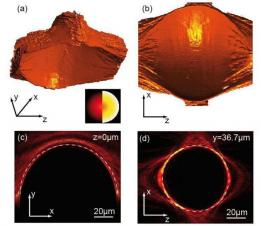
I have a long-standing interest in ultrafast phenomena in optics, and have worked in areas which have included the development of picosecond and femtosecond sources and ultrafast measurement techniques (including frequency resolved optical gating FROG). One major achievement in source development was the co-discovery of the "similariton" regime of optical fibre pulse propagation (a word that I simultaneously take credit and blame for inventing!) which used powerful techniques of the mathematics of self-similarity in nonlinear systems to describe a particular regime of fibre amplifier propagation which allowed pulsed fibre amplifier operation to be scaled to new power levels. More recent work in this area at FEMTO-ST has been in support of the fantastic experiments being led by my colleague Francois Courvoisier (recently awarded an ERC Consolidator Grant) to develop unique and novel degrees of freedom for femtosecond laser ablation and materials processing through the use of so-called "nondiffracting" or "accelerating" beam structures.
Selected Publications
J. M. Dudley, C. Finot, D. J. Richardson, G, Millot
Self Similarity in Ultrafast Nonlinear Optics Nature Physics 3 597-603 (2007).
A. Mathis, L. Froehly, S. Toenger, F. Dias, G. Genty, J. M. Dudley, Caustics and Rogue Waves in an Optical Sea, Scientific Reports 5, Article number: 12822 10.1038/srep12822 (2015)
P. Ryczkowski, M. Barbier, A. T. Friberg, J. M. Dudley, G. Genty, Ghost imaging in the time domain
Nature Photonics 10, 167-170 (2016)
L. Froehly, F. Courvoisier, D. Brunner, L. Larger, F. Devaux, E. Lantz, J. M. Dudley, M. Jacquot, Advancing Fourier: space–time concepts in ultrafast optics, imaging, and photonic neural networks, Journal of the Optical Society of America A 36, C69-C77 (2019)

